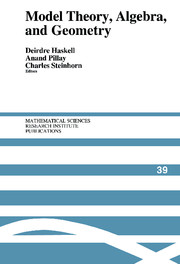Book contents
- Frontmatter
- Contents
- Overview
- Introduction to Model Theory
- Classical Model Theory of Fields
- Model Theory of Differential Fields
- A Survey on the Model Theory of Difference Fields
- Notes on o-Minimality and Variations
- Stability Theory and its Variants
- Subanalytic Geometry
- Arithmetic and Geometric Applications of Quantifier Elimination for Valued Fields
- Abelian Varieties and the Mordell-Lang Conjecture
Arithmetic and Geometric Applications of Quantifier Elimination for Valued Fields
Published online by Cambridge University Press: 26 June 2025
- Frontmatter
- Contents
- Overview
- Introduction to Model Theory
- Classical Model Theory of Fields
- Model Theory of Differential Fields
- A Survey on the Model Theory of Difference Fields
- Notes on o-Minimality and Variations
- Stability Theory and its Variants
- Subanalytic Geometry
- Arithmetic and Geometric Applications of Quantifier Elimination for Valued Fields
- Abelian Varieties and the Mordell-Lang Conjecture
Summary
We survey applications of quantifier elimination to number theory and algebraic geometry, focusing on results of the last 15 years. We start with the applications of p-adic quantifier elimination to p-adic integration and the rationality of several Poincar series related to congruences f(x) = 0 modulo a prime power, where f is a polynomial in several variables. We emphasize the importance of p-adic cell decomposition, not only to avoid resolution of singularities, but especially to obtain much stronger arithmetical results. We survey the theory of p-adic subanalytic sets, which is needed when f is a power series instead of a polynomial. Next we explain the fundamental results of Lipshitz-Robinson and Gardener-Schoutens on subanalytic sets over algebraically closed complete valued fields, and the connection with rigid analytic geometry. Finally we discuss recent geometric applications of quantifier elimination over ℂ ((t)), related to the arc space of an algebraic variety.
One of the most striking applications of the model theory of valued fields to arithmetic is the work of Ax and Kochen [1965a; 1965b; 1966; Kochen 1975], and of Ershov [1965; 1966; 1967], which provided for example the first quantifier elimination results for discrete valued fields [Ax and Kochen 1966], and the decidability of the field ℚp of p-adic numbers. As a corollary of their work, Ax and Kochen [1965a] proved the following celebrated result: For each prime number p, big enough with respect to d, any homogeneous polynomial of degree d over ℚp in d2 + 1 variables has a nontrivial zero in ℚp. However in the present survey we will not discuss this work, but focus on results of the last 15 years.
Information
- Type
- Chapter
- Information
- Model Theory, Algebra, and Geometry , pp. 173 - 198Publisher: Cambridge University PressPrint publication year: 2000
Accessibility standard: Unknown
Why this information is here
This section outlines the accessibility features of this content - including support for screen readers, full keyboard navigation and high-contrast display options. This may not be relevant for you.Accessibility Information
- 1
- Cited by
